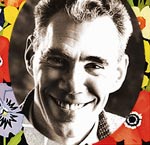|
Hello Joe coincides with ‘Joe Brainard: A Retrospective’ curated by Constance Lewallen now on view at the Berkeley Art Museum in Berkeley, California. Through 2001 and into 2002 the exhibition will travel to Boulder, Colorado, New York City and Las Vegas, Nevada. It includes approximately 150 collages, assemblages, paintings, drawings and magazine covers. This is a drop in the bucket for an artist who had a show of some 1,500 small works — many the size of matchbook covers — in the mid-1970s at Manhattan’s Fischbach Gallery. Brainard’s interest in and affection and respect for poets was so great that he made covers for and/or collaborated with Ron Padgett, Kenward Elmslie, John Ashbery, Jonathan Williams, Anne Waldman, Ann Lauterbach, Lewis Warsh, Tom Clark, Ted Berrigan, Bill Berkson, James Schuyler, Robert Creeley, Johnny Stanton, Alice Notley, Bernadette Mayer, Frank O’Hara, Lee Harwood, Michael Brownstein, Dick Gallup and that is a shortlist. During the nearly twenty years from the early 1960s until he quietly and firmly stopped making art, Joe Brainard’s energy and invention were prodigious.
Joe Brainard was born in Salem, Arkansas in 1942 and reared in Tulsa, Oklahoma. In his first eighteen years he showed talent as an artist by winning local arts competitions, met his friends of a lifetime the poets Ron Padgett, with whom he edited the White Dove Review while in high school, Dick Gallup and Ted Berrigan, and got himself to New York City. There is a species of true New Yorker who is born anywhere but there yet once on the isle of Manhattan is impossible to imagine elsewhere. When he arrived for good in 1963 Joe Brainard became one of these New Yorkers. He immediately entered the downtown scene where poets, painters, musicians and dancers worked and played together as, alas, they seldom do today. In the blink of an eye Brainard became central to that scene and remained so, even after he stopped producing art, until his death from AIDS in 1994.
Joe Brainard is one of those unclassifiable artists, sui generis, who do several things well. In his case this resulted not in separate compartments but a unified whole. Brainard’s work as a painter and assemblagist, as autobiographer in the ‘I remember’ form he invented, as collagist, writer and book cover designer is all of a piece. The same qualities shine forth in all that he produced: clarity, bold simplicity, accuracy of execution and feeling, humor, casual elegance, a charm that invites his audience in rather than keeping them at arm’s length, and something grander but determinedly low key and offhand, a sense of the ordinary as sacramental.
John Ashbery has written that Joe Brainard was ‘nice as an artist and nice as a man.’ Nice may be a surprising word with which to celebrate a late twentieth century New York artist, but it fits Joe Brainard. His work is precise, sensitive, agreeable and pleasing. His art is loved for these virtues and as a man he was loved because he accentuated them with a breathtaking generosity. Those on whom he lavished his attention — and they are many — will not forget him. And they will remember his tact, shyness and modesty. Joe Brainard’s decency as a man is enough to explain this tribute.
The poems and essays that follow attest to the ongoing effect of Joe’s work and character on his friends. A new generation of writers affirms the sustaining pleasure Brainard’s art continues to give.
Our tribute is titled Hello Joe to emphasize the man’s open and direct manner, a man easy to greet. And because we want to say ‘Hi, we miss you.’ But Joe is ultimately generic, too ‘a good Joe.’ Joe Brainard ought to be saluted by his full name. At the close of his memorial essay on Joe’s hero Frank O’Hara Morton Feldman writes: ‘‘The thin tunes, holding lost times and future hopes in liaison,’ wrote F. Scott Fitzgerald. Note how we say his full name. The same is true of Frank O’Hara. It is his full name that conveys the complete meaning of this artist. This could be the subject of a game. How easily the last name of Joyce or Valéry falls on our lips. But we always say ‘Gertrude Stein’ — we always say, ‘E.M. Forster.’ We need that extra sweep to distinguish those who typified an era from those who thrust themselves above it.’ Joe Brainard typified an era, he deserves that extra sweep.
|

